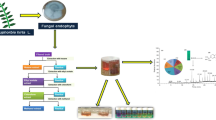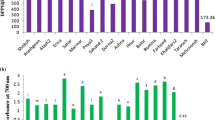Abstract
Cinnamomum zeylanicum and Ocimum basilicum are two plants used by many cultures for food and medicinal purposes. The phenolic composition of ethanol extracts of both plants were determined by HPLC–DAD. A total of seventeen compounds were identified in C. zeylanicum with trans cinnamic acid (179.90 ± 0.45 µg/g) and coumarin (84.50 ± 0.41 µg/g) as major constituents while ten compounds were detected in O. basilicum with rosmarinic acid (360.40 ± 1.28 µg/g) and vanillic acid (36.30 ± 0.25 µg/g) as major constituents. C. zeylanicum exhibited higher inhibition on AChE (54.30 ± 0.97%) and BChE (66.43 ± 0.84%) than O. basilicum with lower AChE (23.43 ± 0.51%) and BChE (33.83 ± 0.75%) inhibitions. Both extracts showed moderate inhibition of tyrosinase and urease enzymes. The quorum sensing (QS) inhibition of O. basilicum and C. zeylanicum was evaluated by two assays: violacein inhibition on Chromobacterium violaceum CV12472 and QS inhibition on Chromobacterium violaceum CV026. Excellent inhibition of violacein synthesis in CV12472 was exhibited by C. zeylanicum with 100% inhibtion at MIC to MIC/4 and further inhibitions of 48.0 ± 2.0% (MIC.8) and 27.9 ± 1.2% (MIC/16). QS inhibition diameter zones on C. violaceum CV026 at MIC were 13.0 ± 1.0 mm and 10.5 ± 1.0 mm for C. zeylanicum and O. basilicum respectively. Since both extracts could inhibit violacein synthesis in CV12472 and QS in CV026, they could block signal production and signal reception in QS mediated processes in bacteria. These results indicate that both plants can be used to remedy microbial resistance and Alzheimer’s diseases.


Similar content being viewed by others
Data Availability
All data obtained and analyzed during this research are provided and included within the manuscript data and the authors will make available any other related information supporting the findings upon reasonable request.
References
Tamfu AN, Ceylan O, Fru GC, Ozturk M, Duru ME, Shaheen F (2020) Antibiofilm, antiquorum sensing and antioxidant activity of secondary metabolites from seeds of Annona senegalensis. Persoon Microbial Pathogen 144:104191. https://doi.org/10.1016/j.micpath.2020.104191
Boudiba S, Tamfu AN, Berka B, Hanini K, Hioun S, Allaf K, Boudiba L, Ceylan O (2021) Anti-quorum sensing and antioxidant activity of essential oils extracted from juniperus species, growing spontaneously in Tebessa Region (East of Algeria). Nat Prod Commun 16(6):1–11. https://doi.org/10.1177/1934578X211024039
Ngenge AT, Ceylan O, Fru GC, Arab Y, Emin DM, Ozturk M (2021) Antimicrobial, antibiofilm, anti-quorum sensing and motility inhibition activities of essential oil from seeds of food spice Xylopia aethiopica (Dunal) A. Rich. on some pathogenic bacteria. Res J Biotechnol. 16(6):68–76
Owokotomo IA, Ekundayo O, Abayomi TG, Chukwuka AV (2015) In-vitro anti-cholinesterase activity of essential oil from four tropical medicinal plants. Toxicol Rep 2:850–857. https://doi.org/10.1016/j.toxrep.2015.05.003
Tehrani MB, Rezaei Z, Asadi M, Behnammanesh H, Nadri H, Afsharirad F, Moradi A, Larijani B, Mohammadi-Khanaposhtani M, Mahdavi M (2019) Design, synthesis, and cholinesterase ınhibition assay of Coumarin-3-carboxamide-N-morpholine hybrids as new anti-Alzheimer agents. Chem Biodivers 16(7):e1900144. https://doi.org/10.1002/cbdv.201900144
Tamfu AN, Fotsing MT, Talla E, Ozturk M, Mbafor JT, Duru ME, Shaheen F (2019) Chemical composition and evaluation of anticholinesterase activity of essential oil from Cameroonian propolis. Issues Biol Sci Pharm Res 7(3):58–63. https://doi.org/10.15739/ibspr.19.007
Tamfu AN, Ceylan O, Kucukaydin S, Ozturk M, Duru ME, Dinica RM (2020) Antibiofilm and enzyme inhibitory potentials of two annonaceous food spices, African Pepper (Xylopia aethiopica) and African Nutmeg (Monodora myristica). Foods 9(12):1768. https://doi.org/10.3390/foods9121768
Jahangir MA, Shehzad A, Butt MS, Shahid M (2018) Influence of supercritical fluid extract of Cinnamomum zeylanicum bark on physical, bioactive and sensory properties of innovative cinnamaldehyde-enriched chocolates. Czech J Food Sci. 36:1–9. https://doi.org/10.17221/237/2016-CJFS
Tamfu AN, Ceylan O, Kucukaydin S, Duru ME (2020) HPLC-DAD phenolic profiles, antibiofilm, anti-quorum sensing and enzyme inhibitory potentials of Camellia sinensis (L.) O. Kuntze and Curcuma longa L. LWT Food Sci Technol 133:110150
Ranasinghe P, Pigera S, Premakumara GA, Galappaththy P, Constantine GR, Katulanda P (2013) Medicinal properties of “true” cinnamon (Cinnamomum zeylanicum): a systematic review. BMC Comp Altern Med 13:275. https://doi.org/10.1186/1472-6882-13-275
Husain I, Ahmad R, Chandra A, Raza ST, Shukla Y, Mahdi F (2018) Phytochemical characterization and biological activity evaluation of ethanolic extract of Cinnamomum zeylanicum. J Ethnopharmacol 219:110–116. https://doi.org/10.1016/j.jep.2018.02.001
Muchuweti M, Kativu E, Mupure CH, Chidewe C, Ndhlala AR, Benhura MAN (2007) Phenolic composition and antioxidant properties of some spices. Am J Food Technol 2:414–420. https://doi.org/10.3923/ajft.2007.414.420
Kumar S, Kumari R, Mishra S (2019) Pharmacological properties and their medicinal uses of Cinnamomum: a review. J Pharm Pharmacol 71:1735–1761. https://doi.org/10.1111/jphp.13173
Wang J, Su B, Jiang H, Cui N, Yu Z, Yang Y, Sun Y (2020) Traditional uses, phytochemistry and pharmacological activities of the genus Cinnamomum (Lauraceae): a review. Fitoterapia 146:104675. https://doi.org/10.1016/j.fitote.2020.104675
Balakrishnan P, Ramalingam PS, Purushothaman S, Balu R, Jolius G, Kumaran S (2018) A comprehensive review on Ocimum basilicum. J Natl Remed 18(3):71–85. https://doi.org/10.18311/jnr/2018/21324
Joshi RK (2014) Chemical composition and antimicrobial activity of the essential oil of Ocimum basilicum L. (sweet basil) from Western Ghats of North West Karnataka, India. Ancient Sci Life 33(3):151–156. https://doi.org/10.4103/0257-7941.144618
Vina A, Murillo E (2003) Essential oil composition from twelve varieties of basil (Ocimum spp.) grown in Colombia. J Braz Chem Soc 14:744–749. https://doi.org/10.1590/S0103-50532003000500008
Tangpao T, Chung HH, Sommano SR (2018) Aromatic profiles of essential oils from five commonly used Thai basils. Foods 7(11):175. https://doi.org/10.3390/foods7110175
Gebrehiwot H, Bachetti RK, Dekebo A (2015) Chemical composition and antimicrobial activities of leaves of sweet basil (Ocimum basilicum L.) herb. Int J Basic Clin Pharmacol 4(5):869–875. https://doi.org/10.18203/2319-2003.ijbcp20150858
Gülçin I, Elmastaş M, Aboul-Enein HY (2007) Determination of antioxidant and radical scavenging activity of Basil (Ocimum basilicum L. Family Lamiaceae) assayed by different methodologies. Phytother Res. 21(4):354–361. https://doi.org/10.1002/ptr.2069
Barros L, Dueñas M, Ferreira ICFR, Baptista P, Santos-Buelga C (2009) Phenolic acids determination by HPLC-DAD-ESI/MS in sixteen different Portuguese wild mushrooms species. Food Chem Toxicol 47:1076–1079. https://doi.org/10.1016/j.fct.2009.01.039
Çayan F, Deveci E, Tel-Çayan G, Duru ME (2020) Identifcation and quantifcation of phenolic acid compounds of twenty-six mushrooms by HPLC–DAD. J Food Measur Charact 14:1690–1698. https://doi.org/10.1007/s11694-020-00417-0
Ellman GL, Courtney KD, Andres V, Featherstone RM (1961) A new and rapid colorimetric determination of acetylcholinesterase activity. Biochem Pharmacol 7:88–95. https://doi.org/10.1016/0006-2952(61)90145-9
Weatherburn MW (1967) Phenol-hypochlorite reaction for determination of ammonia. Anal Chem 39:971–974. https://doi.org/10.1021/ac60252a045
Masuda T, Yamashita D, Takeda Y, Yonemori S (2005) Screening for tyrosinase inhibitors among extracts of seashore plants and identification of potent inhibitors from Garcinia subelliptica. Biosci Biotechnol Biochem 69:197–201. https://doi.org/10.1271/bbb.69.197
CLSI (Clinical Laboratory Standards Institute) (2006) Quality control minimal inhibitory concentration (MIC) limits for broth dilution and MIC interpretative breakpoints (M27–s2). Wayne, Pennsylvania
Ceylan O, Tamfu AN, Doğaç Yİ, Teke M (2020) Antibiofilm and anti-quorum sensing activities of polyethylene imine coated magnetite and nickel ferrite nanoparticles. 3 Biotech. 10(12):513. https://doi.org/10.1007/s13205-020-02509-6
Kocak G, Tamfu AN, Bütün V, Ceylan O (2021) Synthesis of quaternary piperazine methacrylate homopolymers and their antibiofilm and anti-quorum sensing effects on pathogenic bacteria. J Appl Polym Sci 138:e50466. https://doi.org/10.1002/app.50466
Georgiev MI, Alipieva K, Orhan IE (2012) Cholinesterases inhibitory and antioxidant activities of Harpagophytum procumbens from in vitro systems. Phytother Res 26:313–316. https://doi.org/10.1002/ptr.3555
Wang ZY, Liu JG, Li H, Yang HM (2016) Pharmacological effects of active components of chinese herbal medicine in the treatment of Alzheimer’s disease: a Review. Am J Chin Med 44:1525–1541. https://doi.org/10.1142/S0192415X16500853
Amtul Z, Atta-ur-Rahman BSP, Siddiqui R, Choudhary M (2012) Chemistry and mechanism of urease inhibition. Curr Med Chem 9:1323–1348. https://doi.org/10.2174/0929867023369853
Parvez S, Kang M, Chung H, Bae H (2007) Naturally occurring tyrosinase inhibitors: mechanism and applications in skin health, cosmetics and agriculture industries. Phyther Res 21:805–816. https://doi.org/10.1002/ptr.2184
Ruwizhi N, Aderibigbe BA (2020) Cinnamic acid derivatives and their biological efficacy. Int J Mol Sci 21(16):5712. https://doi.org/10.3390/ijms21165712
Zhang WX, Wang H, Cui HR, GuoWB ZF, Cai DS, Xu B, Jia XH, Huang XM, Yang YQ (2019) Design, synthesis and biological evaluation of cinnamic acid derivatives with synergetic neuroprotection and angiogenesis effect. Eur J Med Chem 183:1–16. https://doi.org/10.1016/j.ejmech.2019.111695
Venugopala KN, Rashmi V, Odhav B (2013) Review on natural coumarin lead compounds for their pharmacological activity. BioMed Res Int. https://doi.org/10.1155/2013/963248
Amoah SK, Sandjo LP, Kratz JM, Biavatti MW (2016) Rosmarinic acid-pharmaceutical and clinical aspects. Planta Med 82(5):388–406. https://doi.org/10.1055/s-0035-1568274
Vallverdú-Queralt A, Regueiro J, Martínez-Huélamo M, Rinaldi AJF, Leal LN, Lamuela-Raventos RM (2014) A comprehensive study on the phenolic profile of widely used culinary herbs and spices: rosemary, thyme, oregano, cinnamon, cumin and bay. Food Chem 1(154):299–307. https://doi.org/10.1016/j.foodchem.2013.12.106
Omoba OS, Olagunju AI, Salawu SO, Boligon AA (2019) HPLC-DAD phenolic profiling and ın vitro antioxidant activities of three prominent Nigerian spices. Prev Nutr Food Sci 24(2):179–186. https://doi.org/10.3746/pnf.2019.24.2.179
Elansary HO, Szopa A, Kubica P, Ekiert H, El-Ansary DO, Al-Mana FA, Mahmoud EA (2020) Saudi Rosmarinus officinalis and Ocimum basilicum L. Polyphen Biol Act Process 8:446. https://doi.org/10.3390/pr8040446
Wang Y, Harrington PB, Chen P (2020) Metabolomic profiling and comparison of major cinnamon species using UHPLC-HRMS. Ann Bioanal Chem 412(27):7669–7681. https://doi.org/10.1007/s00216-020-02904-1
Laha S, Sarkar D (2014) Screening of inhibitory effects on acetylcholinesterase and butyrylcholinesterase enzymes by some ındian medicinal plant’s extracts. Indian Res J Genet Biotechnol 6(2):406–411
Arachchige SPG, Abeysekera WPKM, Ratnasooriya WD (2017) Antiamylase, anticholinesterases, antiglycation, and glycation reversing potential of bark and leaf of ceylon cinnamon (Cinnamomum zeylanicum Blume) In Vitro. Evidence Based Comp Altern Med. https://doi.org/10.1155/2017/5076029
Danış Ö, Yuce-Dursun B, Çimen T, Demir S, Salan Ü, Yalçın G, Ogan A (2014) Evaluation of antioxidant, radical-scavenging and acetylcholinesterase ınhibitory activities of various culinary herbs cultivated in southern Turkey. J Food Biochem 38:602–611. https://doi.org/10.1111/jfbc.12095
Amat-ur-Rasool H, Symes F, Tooth D, Schaffert LN, Elmorsy E, Ahmed M, Hasnain S, Carter WG (2020) Potential nutraceutical properties of leaves from several commonly cultivated plants. Biomolecules 10:1556. https://doi.org/10.3390/biom10111556
Lianza M, Mandrone M, Chiocchio I, Tomasi P, Marincich L, Poli F (2020) Screening of ninety herbal products of commercial interest as potential ingredients for phytocosmetics. J Enzyme Inhib Med Chem 35(1):1287–1291. https://doi.org/10.1080/14756366.2020.1774571
Lin CC, Yang CH, Wu PS, Kwan CC, Chen YC (2011) Antimicrobial, anti-tyrosinase and antioxidant activities of aqueous aromatic extracts from forty-eight selected herbs. J Med Plants Res 5(26):6203–6209. https://doi.org/10.5897/JMPR.9000182
Kothari V, Sharma S, Padia D (2017) Recent research advances on Chromobacterium violaceum. Asian Pac J Trop Med 10(8):744–752. https://doi.org/10.1016/j.apjtm.2017.07.022
Alfred TN, Ceylan O, Kucukaydin S, Olmez OT, Godloves CF, Sylvain SK, Yeskaliyeva B, Duru ME, Ozturk M (2020) HPLC-DAD and GC-MS characterization of Cameroonian honey Samples and evaluation of their antibiofilm, anti-quorum sensing and antioxidant activities. Bull Environ Pharmacol Life Sci 9(10):132–142
Popova M, Gerginova D, Trusheva B, Simova S, Tamfu AN, Ceylan O, Clark K, Bankova V (2021) A Preliminary study of chemical profiles of honey, cerumen, and propolis of the african stingless bee Meliponula ferruginea. Foods 10:997. https://doi.org/10.3390/foods10050997
Acknowledgements
The authors are grateful to Department of Chemistry and the Ula Ali Kocman Vocational School, Mugla Sitki Kocman University for material support.
Funding
The authors received no financial support for the research and publication of this article.
Author information
Authors and Affiliations
Contributions
ANT, SK and OC did the conceptualization, performed the literature search, and devised the methods, carried out the experiments as well as the formal analysis. ANT and SK wrote the original draft. OC, MED and NS did the editing, provided materials and resources. OC and MED did the supervision. All authors read and approved the final manuscript.
Corresponding authors
Ethics declarations
Conflict of Interest
The authors declare that they have no conflicts of interest.
Ethics Approval
Not applicable.
Consent to Participate
Not applicable.
Consent for Publication
Not applicable.
Rights and permissions
About this article
Cite this article
Tamfu, A.N., Kucukaydin, S., Ceylan, O. et al. Phenolic Composition, Enzyme Inhibitory and Anti-quorum Sensing Activities of Cinnamon (Cinnamomum zeylanicum Blume) and Basil (Ocimum basilicum Linn). Chemistry Africa 4, 759–767 (2021). https://doi.org/10.1007/s42250-021-00265-5
Received:
Accepted:
Published:
Issue Date:
DOI: https://doi.org/10.1007/s42250-021-00265-5




